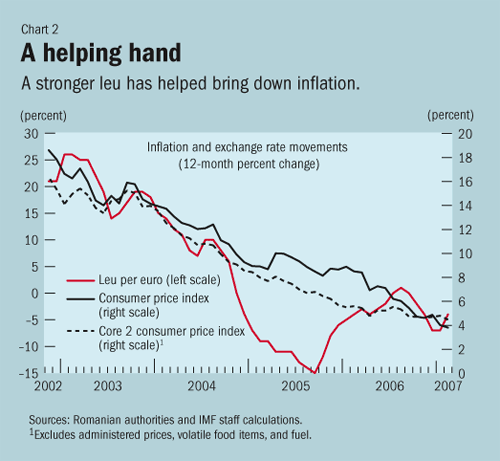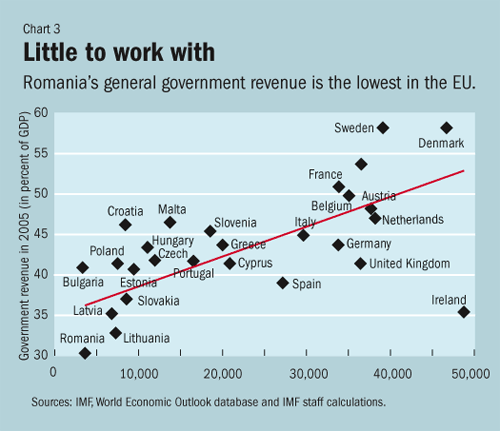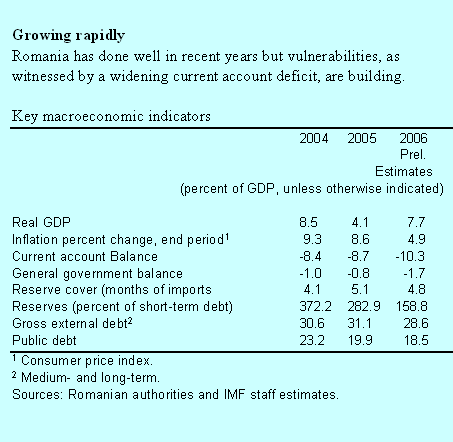
Typical street scene in Santa Ana, El Salvador. (Photo: iStock)
IMF Survey: Romania Aims for EU Living Standards
June 13, 2007
- Prospect of EU membership served as strong policy anchor in past
- Now part of EU, Romania must extend sound policies to benefit from membership
- Change in market sentiment could harm Romania's growth prospects
Romania's accession to the European Union (EU) on January 1, 2007 was a significant milestone following a period of substantial achievements.

EU flag production in Bucharest, Romania, where prospect of EU membership served as strong policy anchor (photo: Mihai Barbu/Reuters)
NEW EU MEMBERS
From the early days of transforming Romania into a market economy, the prospect of EU membership served as a policy anchor, helping to stabilize the economy and advance structural reforms. Now, the big challenge for policymakers will be to ensure macroeconomic and financial stability while at the same time allowing Romania to catch up with the living standards in the rest of the EU.
After a currency crisis in 1999, the authorities took steps to reduce Romania's macroeconomic imbalances through fiscal adjustment and a prudent monetary policy underpinned by inflation targeting (see table). The government also sought to improve the financial performance of state-owned enterprises, and even privatized many of them.
As a result of these policies, output growth accelerated, thus narrowing the income gap with the EU (see Chart 1). Inflation came down and macroeconomic stabilization, combined with the prospect of EU membership, helped create jobs and boost investment and productivity (see Chart 2).

Despite these achievements, challenges remain. Strong credit growth and a widening current account deficit are creating vulnerabilities that will need to be carefully monitored.

Although short-term risks seem manageable, a decline in competitiveness and a change in market sentiment could put Romania's growth prospects in jeopardy. This underscores the need for disciplined policies aimed at maintaining financial stability, reducing emerging macroeconomic imbalances, and sustaining strong growth.
Riding the tiger
With the right policies in place, investor confidence in Romania will remain high, allowing the country to benefit from sizeable foreign direct investment. These flows can accelerate growth, helping Romania catch up with western Europe. But their potentially volatile nature could complicate the conduct of monetary and fiscal policies, either by increasing pressure on the leu to appreciate or by contributing to a widening current account deficit.
Well designed macroeconomic policies can lay the foundation for macroeconomic stability and private-sector growth. If private saving does not increase in line with private investment, public saving will have to increase to relieve some of the pressure on the current account.
Low revenue base
Although the sustainability of Romania's public debt is not an immediate cause for concern, pressing expenditure needs—for instance, in the areas of infrastructure, health, and education—and a low revenue base pose challenges for fiscal policy (see Chart 3). Improved transparency and monitoring within the setting of a strong medium-term fiscal framework will help build credibility. Moreover, a prudent wage policy for public sector employees will help keep inflation down and will encourage the private sector to keep its wage pressures in check.

Romania's inflation-targeting regime has served it well in terms of bringing down inflation. Moving forward, the central bank faces a dilemma: if it chooses to increase interest rates in order to achieve its inflation goals it may result in a further appreciation of the currency. The only lasting solution is to firmly anchor inflationary expectations within a highly credible inflation-targeting framework.
In an environment of volatile capital inflows, a strong financial system is a must. Because the financial system is still in transition, very rapid credit growth could raise vulnerabilities over the medium term. An efficient banking sector is essential for growth but it will be important to ensure that risk is being adequately managed. Effective supervision will help minimize potential problems associated with a sudden reversal in investor sentiment.
Getting the timing right
With Romania now in the EU, policymakers are turning their attention to adopting the euro. Although doing so will entail major challenges, it will also bring important benefits in terms of stability and efficiency gains associated with the single currency.
But before it can adopt the euro, Romania will have to comply with the strict criteria for joining the euro area. The government has rightly emphasized the importance of real convergence and has prepared a realistic timetable.
In order to achieve its goal of adopting the euro, Romania will have to accelerate its structural reform agenda. Top priorities include improving the efficiency of public services, accelerating plans for further privatizations in the energy sector, increasing the size of the labor force and creating more jobs, and reducing corruption, thereby improving the business environment.
Romania's drive to catch up with its richer EU partners will be boosted by financial resources from the EU. Post-accession funds—if used in full—would represent an injection equivalent to 3-5 percent of GDP every year during the period 2007-14. The scale of these inflows underscores the importance of making sure that Romania will be able to put the funds to good use.
In sum, there is no doubt that EU membership is a huge opportunity for Romania. But it will also put its policies to the test. Given the significant gap between living standards in Romania and its richer EU partners, there is no room for complacency.








